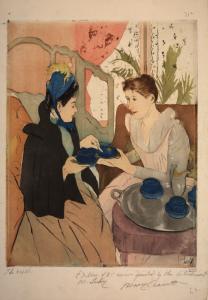Developed in the 1860s early impressionists broke the rules
of then established academic painting. They began by giving colors and shades primacy over lines. Radicals in their time, they set out to recreate the sensation in the eye that views the
subject, rather than simply recreating the subject. The rise of the
impressionist movement is often considered a reaction by artists to the
newly established medium of photography.
Initially photography's presence seemed to undermine the
artist's depiction of nature and their ability to mirror reality. Both portrait
and landscape paintings were deemed somewhat deficient and lacking in realism
as photography produced true to life images in a quicker more efficient fashion.
The photographer taking fixed or still images through the reliable film exposure
process challenged painters as a new way of capturing reality.
 Afternoon Tea Party. Mary Cassatt
| ||
One of the key factors to keep in mind when looking at art
of this style is the lack of fine detail.
This is due to the emphasis of impressionists to portray the overall
visual effects instead of details. Short, thick strokes of paint are used to
quickly capture the essence of the subject. They abandoned traditional perspective, and avoided
the clarity of form which was previously how paintings were distinguished as having greater and lesser elements in a picture.
This has resulted in many critics accusing impressionist paintings of looking
unfinished or amateurish. The perception of such critics is enlightened by understanding
the meaning of the word impression: “an idea, feeling, or opinion about
something or someone, especially one formed without conscious thought or on the
basis of little evidence” - Oxford dictionary (American English). Impressionism draws on the senses not so much
the sensibilities.
The use of color is also an important key in identifying impressionist works. The Impressionists loosened their brushwork, and lightened their palettes with pure, intense colors. Colors are applied side-by-side with as little mixing as possible, creating a vibrant surface. Impressionists used mixed and pure unmixed color, not smoothly blended or shaded as was customary, in order to achieve the effect of intense color vibration. The optical mixing of colors is intended to occur in the eye of the viewer. Grays and dark tones are produced by mixing complementary colors. In pure impressionist paintings the use of black paint is avoided.
The use of color is also an important key in identifying impressionist works. The Impressionists loosened their brushwork, and lightened their palettes with pure, intense colors. Colors are applied side-by-side with as little mixing as possible, creating a vibrant surface. Impressionists used mixed and pure unmixed color, not smoothly blended or shaded as was customary, in order to achieve the effect of intense color vibration. The optical mixing of colors is intended to occur in the eye of the viewer. Grays and dark tones are produced by mixing complementary colors. In pure impressionist paintings the use of black paint is avoided.
"There are no lines in nature, only areas of color, one against another."-Edouard Manet
Impressionist painters purposefully took the act of painting from the studio to the outside world changing the effect of light in their paintings. Previously most still-lifes and portraits as well as landscapes were painted indoors. The impressionists found that they could capture the transient effects of sunlight in the moment by painting en plein air (outdoors).
Using the en plein air technique, shadows are boldly painted with the blue of the sky as it is reflected onto surfaces, giving a sense of freshness and openness not captured in other types of paintings. Blue shadows on snow are the effect said to have inspired this technique. Painting in the evening produces effets de soir - the shadowy effects of the light in the evening or twilight. The evening lighting would look no different from the mid-day when done with the subject indoors instead of outdoors. Lighting is an important element of impressionism, not all paintings are done en plein air, however, it is highly regarded by purists.
 |
| Garden Scene in Brittany. 1886 Pierre-Auguste Renoir |
"If the painter works directly from nature, he ultimately looks for nothing but momentary effects; he does not try to compose and soon become monotonous."-Pierre-Auguste Renoir
 |
| Régate à Argenteuil. circa 1872 Claude Monet |
As outlined in this article impressionist paintings can be determined by taking into consideration the following key factors:
- lack of high detail with boundaries blurred suggesting a three-dimensional plane, rather than a clearly realistic depiction
- colors not smoothly blended yet close attention paid to the reflection of colors from object to object
- the play of natural light is emphasized
- use of thick brush strokes producing a nontransparent finished painting
images used in this essay are public domain. Courtesy: The New York Public Library and Wikimedia Commons












0 comments: